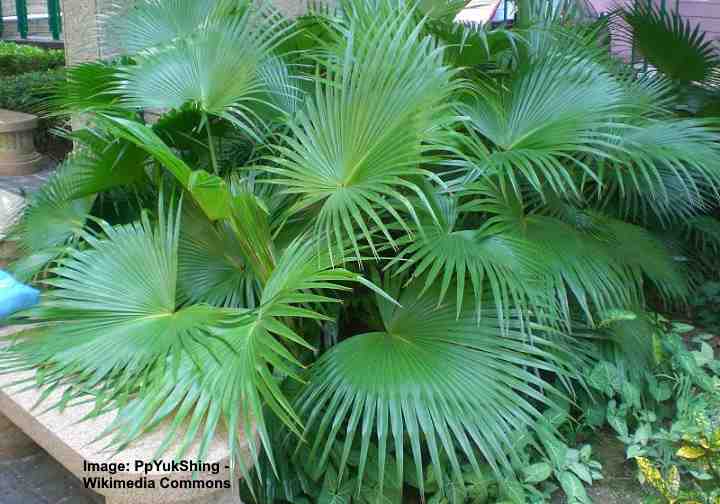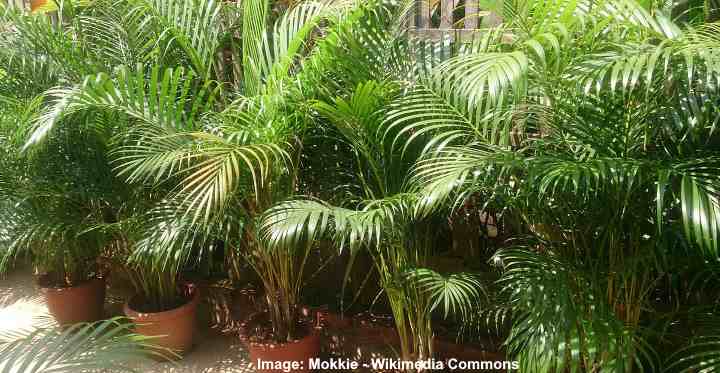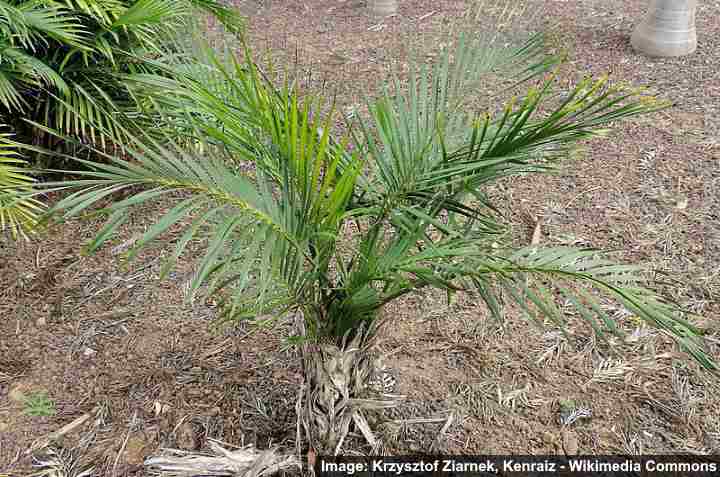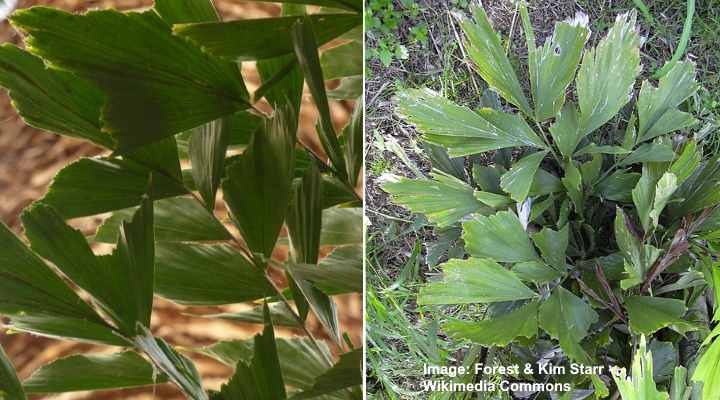Indoor palm trees are a great way to bring the tropics into your home. Arching fronds with thin pointed leaflets on each stalk characterize most palm houseplants. The beauty of any room in your home or workplace can be enhanced using growing indoor palms. Growing palms indoors in lovely pots is fairly simple, even if they have certain particular care needs.
Majesty (majestic) palms, parlor palms, areca palms, cat palms, and kentia palms are the most common varieties of indoor palm plants. These well-known palm houseplants are popular because they don’t take up a lot of space. The lovely leaves of common indoor palm trees brighten up any area or living space.
How to care for indoor palm plants: Place the potted palm tree in well-draining potting soil and place it in a bright location with indirect sunlight. Soil should be moist but not soggy or dry for indoor palm trees to flourish. When the top layer of the soil has dried, water the palm plant. In most cases, fertilize once a month, maintain high humidity, and maintain average room temperature.
The most prevalent concern for indoor palm trees is brown leaf tips. Don’t over-fertilize your palm plant, maintain the soil damp, and increase room humidity to avoid brown tips from forming on the fronds. The brown tips of palm leaves are often trimmed; however, doing so may kill the frond.
If the entire leaf has died and turned brown, you should prune it. The most popular palm species are discussed in this article. You’ll learn more about lesser-known indoor palm house plants as well. A helpful guide on how to care for your exotic, tropical potted plant may be found at the end of the article.
Indoor Palm Plants (With Pictures of Indoor Palm Trees)
Continue reading to find out how to distinguish between the most popular forms of indoor palm plants. Pictures will help you identify the appropriate house or office plant, in addition to their scientific names, for palm identification.
Parlor Palm (Chamaedorea elegans)

The parlor palm is one of the most common indoor houseplant species, and it’s a popular choice. The parlor palm (also known as the neanthe bella palm) is one of the most popular houseplants in the world because it is so easy to care for. The list of houseplants that clean the air includes this palm plant. The plant thrives in high humidity levels, even though it prefers shaded light.
The parlor palm tree can flourish in average indoor light and even some shade when compared to other palm types. Crescent-shaped leaves cover this slow-growing tropical palm. The bushy palm will reach a height of around 6 feet (1.8 meters) when indoors as a potted palm plant. The parlor palm, on the other hand, may require many years of proper care to reach full maturity.
Chinese Fan Palm (Livistona chinensis)

The Chinese Fan palm (also known as fountain palm) is one of the nicest and most striking indoor plants, requiring a lot of room in the home or workplace. It’s simple to see why this tropical palm is called a kind of fan palm plant when you look at photos of it. In any sunny room, the frond leaves look lovely as they are shaped like a star.
The Chinese fan palm is a sluggish grower, as are most types of indoor palm plants. Ultimately, the palm tree should grow to be 10 feet tall (3 meters). Because of its wide distribution, it requires plenty of space in a bright, airy environment. To survive, keep the potted palm plant between 70°F and 80°F (21°C and 27°C) and away from drafts.
Areca Palm (Dypsis lutescens)

The areca palm grows in clusters and has arching, thin leaves that resemble palm grass. It produces a tropical atmosphere to any room. The areca palm, like other indoor palm species, thrives in bright, sunny conditions and is not fond of direct sunlight. Fertilizer salts tend to accumulate in the soil when an areca palm is kept indoors.
Therefore, only feed and flush the soil once or twice each growing season. The areca palm is also known as the butterfly palm because of its feathery, arching fronds that resemble a butterfly. Golden cane palm or yellow palm are two other common names for the areca palm. This palm has bamboo-like stems and foliage that are long and thin.
Cat Palm (Chamaedorea cataractarum)

Cat palm plant is a tiny indoor palm tree that can be grown in bright light and sunny places as long as the sun does not shine directly on the leaves. It is also known as cascade palm. Several palm leaves turn yellow as a result of scorching. This cat palm has long, slender green leaves on its foliage.
The bushy foliage of cat palms makes this a great palm to brighten up a corner since it is a clumping palm. The cat palm grows to be 3.3 feet (1 meter) tall as an elegant houseplant palm.
Ponytail Palm (Beaucarnea recurvata)

The ponytail palm, sometimes known as elephant’s foot palm, has a distinctive appearance that makes it appealing as a houseplant palm. A thick stem or stalk supports the crowning leaves. Even in tiny pots, this palm looks like an elephant’s foot because the base of the stalk is somewhat bigger than the stalk.
The ponytail palm plant is one of the greatest palm trees to cultivate in pots outdoors in temperate regions and thrives indoors. The ponytail palm is a drought-tolerant plant because of its thick root, which holds moisture. When grown in pots, the ornamental palm plant does not grow tall. It may be used in any room of your home that receives moderate shade and no direct sunlight. It’s ideal as a tabletop plant.
Majestic Palm (Ravenea rivularis)

This indoor palm tree, sometimes known as the majesty palm, thrives in humidity and requires minimal care to thrive. The majesty palm, as its name suggests, is majestic. This is one of the most popular houseplant palms because of its long arching fronds.
The majesty palm plant thrives in shaded areas, despite the fact that bright light is a fundamental care need. To thrive indoors, majestic palms need consistent warmth, moist soil, and a lot of air humidity. The brown tips of this palm species are common due to its particular requirements.
The magnificent palm tree may grow up to 98 feet (30 meters) tall, outgrowing your room in the process. It grows at a leisurely pace and can take many years to attain its full height.
Bamboo Palm (Chamaedorea seifrizii)

Indoors, ensure that the bamboo palm is placed in a shady spot to avoid sunburn. Dense vegetation is made up of clumps of slender, cane-like stems with leaves. Bamboo plants thrive in the shade in their natural habitat. As a result, these palms will flourish in the shadow.
The bamboo palm only grows to two or three feet (60–90 cm) when growing indoors in containers. The parlor palm and the areca palm are both known by this little palm tree species. This palm plant has a small stature that makes it a fantastic option when space and light are scarce.
Kentia Palm (Howea forsteriana)

The kentia palm tree is a hardy and maintenance-free palm tree that is perfect for anyone’s garden. The exquisite green leaves of this decorative palm arch upward and slightly upward. These expensive potted palms also add a sense of elevation to a room’s shady area.
The kentia palm is one of the most shade-tolerant of all the palms on this list, which is one of the reasons it’s chosen for indoor growing. The drought-tolerant plant is happy in the winter and enjoys low maintenance. The kentia palm does not grow excessively tall, unlike some indoor plant trees. The best way to avoid browning palm leaf tips is to keep the soil moist and the air humid.
Lady Palm (Rhapis excelsa)

The glossy, dark green fronds and lush growth habit of broadleaf lady palm plant make it a frequent potted palm tree in workplaces with low lighting and humidity requirements. The large palm leaves are one of the distinguishing features of this palm. The leaves’ ends are not tapered, but have saw-toothed edges, unlike other houseplant palms.
When it grows in pots, the lady palm looks like bamboo. This plant is marketed as a bamboo palm, similar to Dypsis lutescens (Areca palm) and Chamaedorea seifrizii (Bamboo palms). As a result, whenever possible, look up the scientific name or study palm photos for confirmation.
Fishtail Palm (Caryota mitis)

The fishtail palm leaves are a one-of-a-kind decorative element, and they add an extra touch of elegance to any indoor area. This palm houseplant is a stunner because of its uniquely-shaped leaves, interesting texture, and upward growth habits. This palm thrives in bright areas with enough humidity as long as it isn’t exposed to direct sunlight.
Indoor container growing of fishtail palms is possible. They are simple to cultivate and require no special treatment or cultivation techniques different from other palm species. To avoid brown tips on the leaves, keep the soil moist, give deep watering every few months, and fertilize every other month.
Sentry Palm (Howea belmoreana)

The sentry palm has long slender stems and a crown of glossy green foliage, so keep it in a smaller pot to control its development indoors. The sentry palm leaves arch more than the other kind of palm. Both are cultivars of the same palm genus Howea, as indicated by their scientific names.
Sentry palms and kentia palms are huge palm trees in their natural habitats. When grown indoors, the palm only grows to a height of around 10 feet (3 meters). Growth will be limited if the house palm is kept in a small container. It might contribute a tropical aspect to a brightly-lit area, workplace, hallway, or entryway by having broad fronds.
Pygmy Date Palm (Phoenix roebelenii)

The pygmy palm is a tiny form of palm that necessitates regular misting and should be kept in tropical climates. The pygmy date palm is a breeze to care for when compared to other indoor tropical palms. In Florida landscaping, this kind of palm tree is highly favored. The pygmy palm’s fronds are thinner than those of other palms, as you may see in photographs.
The traditional palm-leaf form of these fronds arches over. Pygmy palms may only grow to around 4 ft. (1.2 m) in containers indoors, which is ideal if you don’t have much space. Keep the potted palm plant in bright, indirect light, as with most tropical palms that are suited for indoor growing.
Ideal placement for the pygmy palm is in a sunny spot during the day. Tips should be able to avoid browning by occasional misting and watering only when necessary.
European Fan Palm (Chamaerops humilis)

The European fan palm has spiky fronds that grow in a star shape, similar to the Chinese fan palm. It is a slow-growing low-maintenance indoor palm plant. Since they thrive in a variety of temperatures and don’t mind being in some shade, European fan palms are simple plants to maintain indoors. They can even handle typical room humidity, which few palms can do.
European fan palms are a tiny houseplant that is easy to care for. When they’re about 1 ft. (30 cm) tall, these palms are normally sold, and after a few years, they’ll be around 3 ft. (90 cm). These are slow-growing plants that take 10 years or more to reach full height indoors. You will, however, need a large area for a mature fan palm to develop since it has a large spread.
Palm-Looking Plants That Are Not True Palms
Sago and yucca plants do not resemble palm plants in any way. Nonetheless, palm-looking plants may be a nice alternative to genuine palms and will instantly boost the look of your home or office.
Sago Palm (Cycas revoluta)

When grown indoors, the sago palm needs well-draining soil and bright light. Sago palms are cycads belonging to the family Cycadaceae, despite being known as a palm type and resembling a palm. The heavy, fuzzy sago palm trunk resembles a pineapple bursting out of the ground.
Long, stiff fronds arch out from the thick stem, with upward-growing leaflets. As an indoor palm, a sago palm has a lifespan of roughly 15 years. It is critical to water your palm on a regular basis, maintain humidity high, and place it in bright light in order for it to thrive.
Yucca (Yucca aloifolia)

If your home or apartment doesn’t get a lot of sunlight, but you need some greenery, yuccas are an excellent option. They tolerate a wide range of conditions.
Yuccas require less light than do house palm plants, but they are not palms. They can endure dry spells and thrive in partly shaded areas. So, if you can’t grow indoor palm trees due to the wrong environment, choose a yucca plant.
Indoor Palm Tree Care: How to Care For Palm Houseplants
Indoor palm trees require more attention than standard houseplants. Enough light, maintaining high humidity, and watering correctly are the basic care requirements. Let’s take a look at how to care for your tropical potted palm in just a few steps.
Light
Bright, indirect light is required for virtually all palm species to survive. The leaves are scorched or burnt by too much direct sunlight. Indoor palms do not flourish in low light, with the exception of the parlor palm, which thrives in low light. Therefore, to ensure the palm gets enough morning or evening sun, pick a spot that is shaded in the mornings and evenings.
Soil
For indoor palms, use well-draining, light potting soil to plant them in a pot. Peat moss, shredded bark, leaf mold, and perlite should be used as a palm fertilizer. You may alternatively purchase cactus mix or regular commercial potting soil. Palm pot soil must be able to drain well and retain moisture in order to be considered suitable for planting.
Water
Only water your palm when the top 1″ to 2″ (2.5 – 5 cm) of soil has dried out. In waterlogged, soggy soil, palms will die and be unable to sit in water. However, parched soil will withholding much-needed moisture from the palm. Brown tips on the leaves are one of the signs that an indoor palm hasn’t been watered properly; the other two reasons are a lack of humidity and too much fertilizer.
Humidity
Since they are tropical plants, most palms need a high level of humidity to survive. Palm trees prefer a more humid environment. Misting the leaves daily, using a humidifier, or placing the plant pot on a pebble humidification tray are some of the ways to mitigate humidity concerns with palms.
Temperature
Ideal room temperatures for healthy indoor palms are between 77 and 80 degrees Fahrenheit. Palm trees need a temperature of 45°F (7°C) to thrive, according to researchers. Your palm will acquire reddish-brown leaves if anything falls below that.
Palms grow well indoors between 60°F and 80°F (15.5°C and 26.6°C) during the growing season. The optimal temperature range seems to be 55°F to 60°F (12°C to 15.5°C) in the winter.
